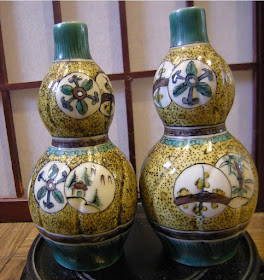Matsuyama Gama existed from 1848 to 1863. In 1863 the name was changed to Matsuyama Okami Kiln. Matsuyama ceased production in 1872. The color and style of original Matsuyama Ao-de Kutani look like Yoshidaya Kutani which was the revival of Ko-kutani, aka old Kutani.
.jpg)
.jpg)
Matsuyama Gama mark: 松山窯
This style of Kutani is referred to by a few different, but similar names, often mistakenly called Ao Kutani, but the correct term is Ao de Kutani, Aote Kutani or Aode Kutani.
Ao-de Kutani uses four colored overglaze enamels: green, yellow, blue and purple to cover the surface of vessels. Ao-de Kutani is characterized by its deep green color. (Ao means blue in modern Japanese). Ao-de Kutani originated from Ko Kutani ware , which was produced between the mid-17th century and the early 18th century. About 120 years after the production of Ko Kutani ware stopped, Yoshidaya kiln revived the Ko Kutani style and produced aote Kutani in the early 19th century. After Yoshidaya kiln stopped production, aode Kutani was produced by Matsuyama Kiln from 1848 to 1863.
Matsuyama gama is well known as the ’good’ kiln which production was devoted at the beginning for the sole usage of the Han.
For Sale. $4000 usd/obo + shipping & insurance

.jpg)
Do you have email adress where I can send you a picture... I have beautiful Japanese porcelain vase which I thought to be from Meiji-era but Japanse cook told me it is earlier but couldn't gave me any further information... Kindly regards - Jason my email is jason_makinen@hotmail.com =)
ReplyDeleteYou can share it here
DeleteI have been trying to find anything similar to this piece but the only thing I can find is your pieces seem to have same mark. Do you have any feedback on this piece that you could share? Not sure how to attach pix.
ReplyDeleteDonna
Thank you for the article. Kutani ware from Matsuyama kiln is very rare these days, mainly kept in old collections and museums.
ReplyDeleteI have li fu yang silk paintings from after wwii Japan era “happy family” and “proud”. I have two sets or total of four paintings. 10x10 inches framed. My father brought them back after Korean War from Japan.
ReplyDeleterbird6@att.net
Delete